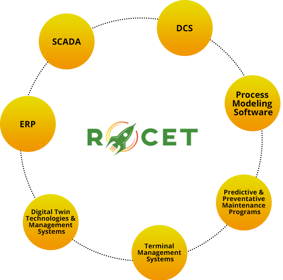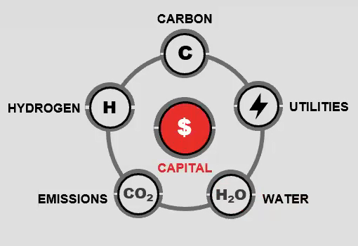IRPC Americas ONLINE: Building the future refinery and a pathway to the most-profitable enterprise
Hydrocarbon Processing’s IRPC Americas ONLINE technical event opened with an informative presentation by Lance Medlin, Group Executive Vice President and Chief Operating Officer, Meridian Energy Partners. His presentation discussed how Meridian has incorporated design and construction technologies into the Davis refinery to eliminate risk wherever possible, and to mitigate risk to its fullest extent.
Meridian Energy Partners is developing two grassroots refineries—the Davis refinery in Billings County, North Dakota and the Permian refinery in the Permian shale region of Texas. For his presentation, Mr. Medlin focused on the development of the $750-MM, 49,500-bpd Davis refinery. The refinery, which is the first full conversion, grassroots refinery built in the U.S. in more than 40 yr., is scheduled to begin operations in 2Q 2023. Once completed, it will be one of the cleanest refineries ever built.
Mr. Medlin provided several de-risking strategies being used in the development of the Davis refinery—design, construction and operations. Specifics of each de-risking strategy include:
- Design: Utilized proven, high-efficiency licensed process technologies, along with low-emission fired sources to comply with permitted air emissions regulations. Meridian also used 3D modeling in the design phase to reduce interference, provide precise material takeoff, streamline creation of a digital twin and the creation of operator training and maintenance tools. Lastly, the project is using smart I/O to reduce installation documents, streamline installation and commissioning efforts and enable surveillance of critical instrumentation for predictive maintenance.
- Construction: The Davis refinery will be a modular design to reduce field installation time and impacts of weather on unit installation, among others.
- Operations: The refinery will provide real-time emissions monitoring to ensure environmental compliance (e.g., ELDAR), use an integrated CMMS for predictive maintenance, utilize AI for supporting changes in operation/planning, building advanced analytics to integrate financial, logistical, mechanical and operational priorities for optimizing short-term and long-term profitability and the implementation of ROCET.
ROCET program. Meridian’s ROCET Center helps eliminate and/or manage risk in the day-to-day operations of the refinery by adding cutting-edge process modeling programs to an already-complex operations program. The ROCET program (FIG. 1) consists of a collaboration of digital and operations technologies combined with administrative and financial control software—DCS, SCADA, enterprise resource planning, terminal management systems, digital twin technologies and management systems, process modeling software, predictive and preventive maintenance programs.

The remote operating center receives data as a read-only feed, which allows safe remote access to operational and process analysis by multiple engineering and technology resources from various sites to a central location. This process increases engineering collaboration without exposing additional human resources to process and terminal loading environments.
The ROCET program will be used for the following items:
- Validate overall design, hydraulics and relief system design
- Develop, manage and maintain operating procedures and training competencies programs
- Optimize processes and troubleshooting while in operation.
The digital technology will also provide plant-wide data gathering, display and metrics; advanced process control and systems integration; advanced analytics using economic optimization tools; integration of multiple operating facilities through common technologies function; and connect multiple business units (e.g., operations, technologies, business and accounting functions, product offtake, storage and logistics, etc.).
Mr. Medlin’s presentation was followed by Keith Couch, Senior Director-Technology Sales and Integrated Projects, Honeywell UOP, who focused on the pursuit of sustained profitability and how a company can benchmark efficiencies of their investments.
Mr. Couch began his presentation on how traditional fuel and petrochemical importers are now investing in capital-intensive complexes to produce products to satisfy increasing domestic demand. “As we continue to see the world build out, we are seeing a major trend emerging,” said Mr. Couch, “Large, world-scale international fuel projects going into places where they used to import fuels…they are now building the fuels import infrastructure themselves. This buildout will offset traditional import markets and these investments are also extending into petrochemicals production.”
Although not all refiners will need to integrate petrochemicals production, a clear trend is emerging in the refinery of the future. According to Mr. Couch, the refinery of the future is:
- Flexible to meet the rapidly changing feed and products market
- Connected to achieve best operating performance every day
- Integrated with petrochemicals to achieve higher margins and value.
The E6 methodology/framework. Mr. Couch focused the last half of his presentation on Honeywell UOP’s E6, which is a framework/methodology to define a step-wise investment strategy to capture and engineer the most profitable enterprise possible. The UOP E6 methodology analyzes the efficiency of six key elements: carbon, hydrogen, utilities, emissions, water and capital (FIG. 2).

The E6 methodology details the path for these six elements. These include:
- Carbon—Putting the right molecules in the right place
- Hydrogen—Optimizing the sources and uses
- Utilities—Doing more with less
- Emissions—Providing for a greener tomorrow
- Water—Treated not as a utility but as a scare resource
- Capital—Driving for the most bankable project.
Mr. Couch detailed the first 12 questions to ask when defining a company’s framework growth. These questions are:
- What products are you selling at a discount?
- What streams do you want to create more of, or avoid?
- How constrained is your steam methane reformer?
- Do you ever need to shift operations due to hydrogen availability?
- What are you fuel gas, power and steam costs/drivers?
- Are you facing infrastructure constraints that impact any of these?
- What is your carbon tax rate?
- How are you performing against existing emission permits?
- Are you concerned about water availability?
- What is your cost for water?
- What is your investment hurdle rate?
- What are you financing constraints?
The E6 methodology provides a way to better align competing business wants and needs at the process, site or enterprise level, as well as a benchmark against where the industry is going, not just the installed peer group.
IRPC Americas ONLINE continues through Wednesday, September 23. Visit www.irpc-americas.com for more information.






Comments